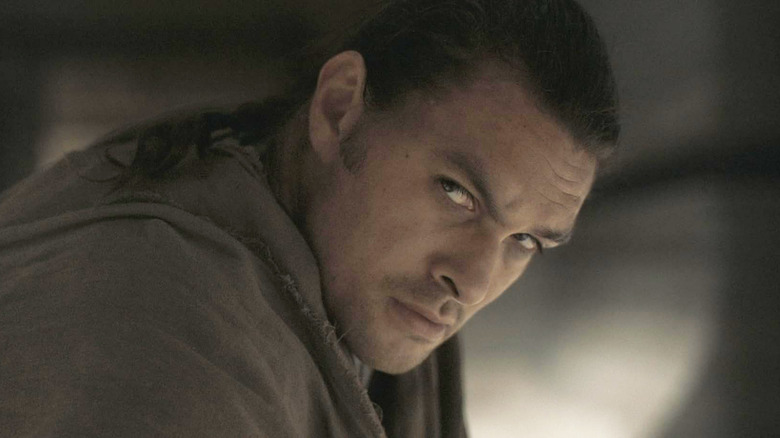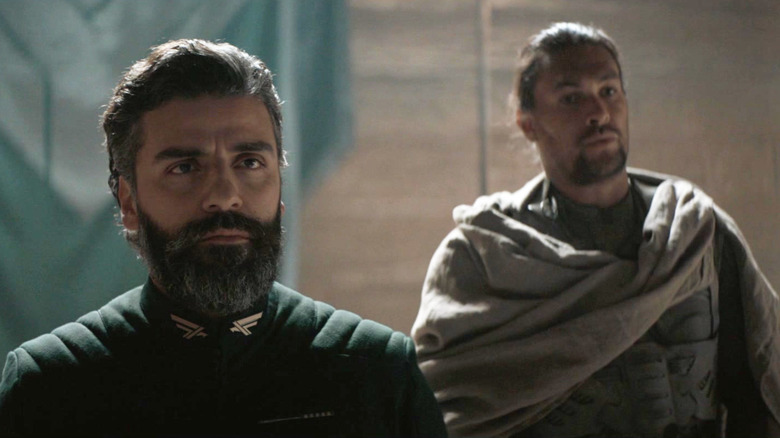Jason Momoa Shot His Own Mock Dune Scenes That Wound Up In The Movie
In Denis Villeneuve's 2021 sci-fi epic "Dune: Part One," Jason Momoa plays Duncan Idaho, a Gonaz Swordmaster in the service of House Atreides. He was robust and friendly, kind to the young Paul (Timothée Chalamet), and capable in a fight; he famously killed multiple Sardaukar warriors before being overwhelmed and slain during a Harkonnen raid on the Atrides' mansion in Arrakeen. Despite this, Frank Herbert's second "Dune" book, "Dune Messiah," sees Duncan return as a clone, Indeed, Duncan clones, called "gholas," appeared throughout Herbert's six original novels, making Duncan Idaho the only "Dune" character to hold that distinction.
Villeneuve's "Dune" was filmed in the deserts of Jordan, specifically the Wadi Rum region, making for unbearably hot shooting days. When Momoa spoke with Entertainment Weekly about filming "Dune," he admitted he was wont to explore those deserts in his spare time. He explained how Villeneuve ensured all the actors and crew were on the same page by distributing an 80-page "Bible" detailing the mythos of the "Dune" universe, the kinds of shots he wanted to include, and how each character played a part in a grand sociopolitical tapestry.
While waiting to film his scenes, Momoa, in costume, would wander out into the sands of Jordan to take a look around. He was kind enough to film his experience, and the actor seemed impressed and bemused by the beauty of the country. It also, he felt, helped him get into character as Duncan Idaho. It seems that these independent sojourns were spotted by Villeneuve and the director — impressed by what he saw — decided to recreate some of Momoa's videos in the final cut of "Dune."
Alone on Arrakis
Momoa wanted to get a sense of the place, absorbing what it might feel like to be alone in the deserts of Arrakis. In his own words:
"I went there and I went with my buddies and we went and shot in the desert just like to have the feeling of being on Arrakis by myself. I was in wardrobe and went out and wandered around from I guess, say 11 to 3, in the middle of the day, and we'd go shoot in different places and climb mountains and do all this different stuff. [...] We made a little piece and we showed it to Denis and he was so inspired by that the next day they didn't let me go."
Villeneuve gathered up Momoa and his cinematographer, Greig Fraser, and they returned to the same locations where Momoa had filmed the home videos. Villeneuve then recreated the scenes in his own idiom, all based on Momoa's ideas. Momoa, like any thoughtful actor, contributed to the fabric of the film by offering his take on the material. Villeneuve, ordinarily a mere stylist, added some humanity to "Dune" as a result. The actor continued:
"He took me and we just went out and shot very simply with Greig. And that shot ended up being in the movie. So it was really cool to like [...] he was having so much fun, just you know, that we went to go play."
Know, then, that Momoa provided a proof-of-concept scene — or at the very least, a few notable shots — of Duncan Idaho. Should Villeneuve choose to make a movie based on "Dune Messiah," rest assured that Duncan Idaho will indeed return.

